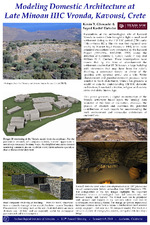| dc.creator | Glowacki, Kevin T | |
| dc.creator | Dafedar, Sayed Kashif | |
| dc.date.accessioned | 2020-05-17T21:58:10Z | |
| dc.date.available | 2020-05-17T21:58:10Z | |
| dc.date.issued | 2010 | |
| dc.identifier.citation | Glowacki, K.T., and S.K. Dafedar. “Modeling Domestic Architecture at Late Minoan IIIC Vronda, Kavousi, Crete.” Poster presented at the 111th Annual Meeting of the Archaeological Institute of America, Anaheim, CA, January 6–9, 2010. DOI: 10.13140/RG.2.1.4712.1444 | en |
| dc.identifier.uri | https://hdl.handle.net/1969.1/187998 | |
| dc.description | Glowacki, K.T., and S.K. Dafedar. “Modeling Domestic Architecture at Late Minoan IIIC Vronda, Kavousi, Crete.” Poster presented at the 111th Annual Meeting of the Archaeological Institute of America, Anaheim, CA, January 6–9, 2010. DOI: 10.13140/RG.2.1.4712.1444. | en |
| dc.description.abstract | Excavations at the archaeological site of Kavousi Vronda in eastern Crete brought to light a small rural settlement dating to the LM IIIC period (12th-early 11th centuries B.C.). At the time of abandonment, the settlement consisted of 15-20 houses, a large building with storerooms that may be the ruler's dwelling, a communal temple, and a kiln. While abandonment and post-abandonment processes have resulted in much disturbance, Vronda has provided a wealth of data for understanding LM IIIC domestic architecture, household activities and society at the end of the Bronze Age. This poster presents a digital reconstruction of the Vronda settlement, based upon the data (hand-drawn plans, section and elevations) recorded at the time of excavation, and evaluates the potential contribution of various graphics software for modeling the vernacular architecture of LM IIIC Crete. AutoCAD tracings of the original data were imported into Autodesk 3ds Max to render the topographic contours of the hill and extrude walls and features of individual buildings. Proposed reconstructions of no longer preserved details such as roof construction, door lintels, and chimneys were added directly in 3ds Max. Panoramic photos taken from the summit were mapped onto a cylinder to provide a photorealistic representation of the surrounding landscape. The project suggests several ways in which models of this type enhance archaeological research and provide new insights into the built environment of an ancient community. | en |
| dc.publisher | K.T. Glowacki | |
| dc.rights | Attribution-NonCommercial-NoDerivatives 4.0 International | en |
| dc.rights.uri | http://creativecommons.org/licenses/by-nc-nd/4.0/ | |
| dc.subject | Archaeology | en |
| dc.subject | Greek Archaeology | en |
| dc.subject | Aegean Archaeology | en |
| dc.subject | Minoan Archaeology | en |
| dc.subject | Crete | en |
| dc.subject | Bronze Age | en |
| dc.subject | Early Iron Age | en |
| dc.subject | Vernacular Architecture | en |
| dc.subject | Domestic Architecture | en |
| dc.subject | Household Archaeology | en |
| dc.subject | 3D Modeling | en |
| dc.subject | Architectural History | en |
| dc.title | Modeling Domestic Architecture at Late Minoan IIIC Vronda, Kavousi, Crete | en |
| dc.type | Presentation | en |
| dc.identifier.doi | 10.13140/RG.2.1.4712.1444 | |



